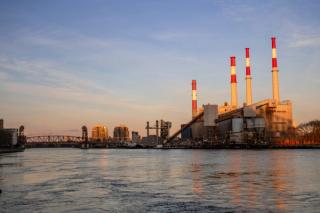
Product-focused emission reductions: Shifting to a life cycle perspective
- Post Date
- 21 October 2025
- Read Time
- 8 minutes

What if your biggest opportunity to reduce emissions lies beyond your facility’s fence line?
For decades, greenhouse gas (GHG) emissions accounting has focused on facility- or company-level inventories. These traditional inventories, whether for regulatory compliance or voluntary reporting, have helped operators understand their direct emissions and identify site-specific mitigation opportunities. But as the science of emission measurement continues to evolve, driven by global purchasing behavior that favors low-emission solutions, so does the scientific community’s approach to identifying and reducing emissions.
In the natural gas and liquefied natural gas (LNG) sector, research over the past decade [1] has revealed significant variability in emissions across the supply chain, even among facilities in the same region or owned by the same operator, making what we knew about GHG inventories useful, but not accurate enough for both the operator and buyer to inform decision-making at the product-level. Financially incentivized, there is market demand from downstream natural gas and LNG buyers seeking low-emission gas as part of their energy transition plans, as well as regulatory drivers, such as the European Union’s Methane Emission Regulation (EUMR) [2]. LNG operators especially are seeing this growing demand, and are partnering with scientists and greenhouse gas experts, like SLR, to right fit their emission inventories.
We believe that to truly drive meaningful emission reductions and support a differentiated gas market, the industry must shift from a facility-focused mindset to a product-focused one, leveraging life cycle assessments (LCAs) to understand and reduce emissions across the supply chain.
What is a life cycle assessment (LCA)?
A life cycle assessment (LCA) is a scientific framework used to estimate the environmental impact (emissions) associated with a product (natural gas) through its lifetime (cradle to grave), or up to a specific transfer point (cradle to gate), such as the point of sale to a downstream buyer. Unlike traditional GHG inventories, which focus on emissions from a single facility over a specific time period, LCAs take a broader view, focusing on the end product. This framework accounts for all the emissions associated with the product as it moves through the supply chain, including upstream production, processing, transportation, and downstream consumption.
In the context of LNG, this means evaluating the carbon footprint of a specific molecule of gas, not just based on where it was produced, but also how efficiently it was processed, shipped, and ultimately used. This product-focused approach enables operators to make more informed decisions, identify emission hotspots throughout their supply chain, and research targeted mitigation strategies that would have the biggest net impact on the emissions intensity of the product. Critically, in the context of a differentiated gas market where buyers are paying a premium for low emission gas, LCAs provide the most comprehensive understanding of the emissions associated with the natural gas or LNG.
What lessons are LNG clients learning through life cycle assessments?
We understand the contribution of each source across the supply chain relative to the product, overcoming the challenges of disparate scales of facilities
Natural gas does not travel in a straight line from the producer to the consumer, it moves through a vast, interconnected network of transmission pipelines, combining with other producer supplies before being used for energy. Each supply chain pathway is unique, influenced by how the gas was produced, gathered, if it was processed, how many compressor stations and miles of transmission pipeline it traversed, where it was delivered, etc. Companies produce different volumes of natural gas, and each company’s footprint is unique in terms of the exact scope of operations. This makes it hard to compare one company’s inventory to another’s. Even if this was possible, those numbers would not reveal the totality of emissions created to deliver a single unit of gas to an end purchaser.
A lifecycle approach shifts the focus from the companies to the product itself. Instead of comparing Company A to Company B, the focus is on comparing Supply Chain A to Supply Chain B, with each delivering the same amount of natural gas to the customer. The result is an emissions inventory tied to a defined unit, such as one mega-joule of natural gas delivered. This inventory clearly communicates what percentage of the emissions were from production versus processing, for example, and if done in detail can provide insight into the exact sources of the emissions (e.g. flaring, fugitives) and the emission species (CO₂ or CH₄, for example).
With product-normalized data, we can avoid the messy accounting that comes with trying to compare inventories from facilities or companies with mismatched operational scopes or sizes.
Product-focused accounting makes it easier for buyers to understand emissions and make educated decisions on their purchase
Natural gas supply chain operations can vary greatly depending on the location of the production site, and where in the world it was delivered. One country may supply pipeline natural gas to a buyer, with another country exporting natural gas as LNG and shipping to the customer. Comparing these two supply chains would be very difficult with inventories alone.
If a buyer only looks at one stage of the supply chain, like production, to make an educated decision about a gas purchase, this at-stage decision may not point to the lowest-emission option. Life cycle accounting considers the entire supply chain operations to deliver the natural gas to a common point (such as the downstream buyer's facility). Whether it was transported via pipeline or imported from an overseas producer, the consumer would have a transparent view into the emission accounting of each product on an “apples to apples” basis.
We can inform business decision-making and robust climate strategy, ensuring mitigation resources are best spent and a net GHG reduction is achieved
LCAs let companies test how different strategies affect their overall greenhouse footprint and help operators avoid unintended consequences due to misleading data. For example, imagine a liquefaction terminal deciding between onsite gas-powered electricity and buying power from the electrical grid. If this operator were only looking at direct facility emissions, the grid option would naturally seem lower emission, but an LCA could reveal that the grid relies heavily on coal, making the LNG product’s total emissions on a life cycle basis higher than expected.
By taking a holistic view, LCAs show the true impact of each choice within the operator’s supply chain line and may uncover opportunities beyond the facility itself. Through a robust LCA, an operator could reveal that their biggest lever to reduce emissions may be in their gas purchasing strategy or pipeline capacity decisions, opportunities that would not be discovered in traditional GHG inventories.
So why isn’t everyone conducting LCAs?
The answer is simple: they’re complex. Life cycle assessments can be resource- and time-intensive, requiring deep technical expertise, access to high-quality data, and a nuanced understanding of supply chain dynamics. But as global regulations tighten in LNG import markets like the EU, and as buyers demand greater emissions transparency [3], the pressure is mounting on operators to proactively prepare their own product-based inventories.
How to Prepare for a Future LCA
Global markets recognize the importance of a low-emission LNG supply chain, and to remain competitive, LNG companies will need to prepare to provide this level of emissions transparency to their customers.
LCA Preparation Checklist
1. Trace your supply chain
While not a strict requirement for life cycle assessment, understanding and tracing your supply chain is a critical first step in conducting an LCA. The more specific your LCA is to your actual supply chain, the more informative the results will be.
2. Enhance your Company GHG Inventory
Like any model, the quality of the output will be limited by the quality of the data input. GHG inventories are a key data source for carbon footprint LCAs. Incorporating measurement data into traditional inventories will ensure mitigation approaches tackle the lowest hanging fruit first.
3. Collaborate with Upstream and Downstream Suppliers
One of the hardest parts of an LCA is often data availability for your upstream and downstream supply chains. Generally, the farther away you get from your own operations, the more “data poor” you are. Building strong relationships with your upstream and downstream suppliers is the easiest way to collect high quality data for your LCA.
How SLR can help
SLR helps clients turn complex emissions challenges into clear, actionable solutions. We combine our decades of experience in emissions measurement (including our contributions to Measurement-Informed Inventory (MII) initiatives such as AMI, OGMP 2.0, MiQ, and QMRV) and reporting for the natural gas supply chain with our technical modeling background in LCA to design for our clients an LCA that fits their specific goals. There is no “one size fits all” strategy to reducing emissions, so why should the data informing your strategy be?
If you’re ready to make the shift to a product mindset, we’re ready to support your journey.
Contact usResources
[1] https://pubs.acs.org/doi/10.1021/acssuschemeng.4c07162
[2] https://eur-lex.europa.eu/eli/reg/2024/1787/oj/eng
[3] https://www.jogmec.go.jp/english/news/release/news_08_00019.html
Recent posts
-

-

-

Transforming the Food & Beverage industry: From compliance only to business-driven decarbonisation
by Vincenzo Giordano, Joseph Payne, Stéphane Rapoport
View post